Related Research Articles

The ruins of Linlithgow Palace are located in the town of Linlithgow, West Lothian, Scotland, 15 miles (24 km) west of Edinburgh. The palace was one of the principal residences of the monarchs of Scotland in the 15th and 16th centuries. Although maintained after Scotland's monarchs left for England in 1603, the palace was little used, and was burned out in 1746. It is now a visitor attraction in the care of Historic Environment Scotland.
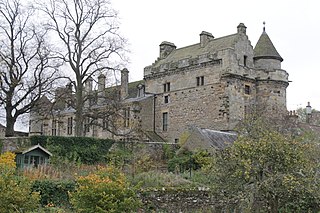
Falkland Palace, in Falkland, Fife, Scotland, is a royal palace of the Scottish Kings. It was one of the favourite places of Mary, Queen of Scots, who took refuge there from political and religious turmoil of her times.

John Erskine, 2nd Earl of Mar was a Scottish politician, the only son of another John Erskine and Annabella Murray. He is regarded as both the 19th earl and the 2nd earl.

Alexander Seton, 1st Earl of Dunfermline (1555–1622) was a Scottish lawyer, judge and politician. He served as Lord President of the Court of Session from 1598 to 1604, Lord Chancellor of Scotland from 1604 to 1622 and as a Lord High Commissioner to the Parliament of Scotland.
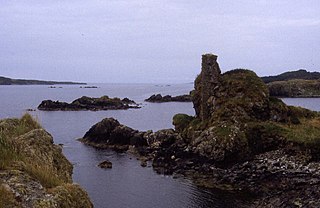
Dunyvaig Castle, is located on the south side of Islay, in Argyll, Scotland, on the shore of Lagavulin Bay, 4 kilometres from Port Ellen. The castle was once a naval base of the Lord of the Isles, chiefs of Clan Donald. It was held by the chiefs of the Clan MacDonald of Dunnyveg.
The Battle of Carberry Hill took place on 15 June 1567, near Musselburgh, East Lothian, a few miles east of Edinburgh, Scotland. A number of Scottish lords objected to the rule of Mary, Queen of Scots, after she had married the Earl of Bothwell, who was widely believed to have murdered her previous husband Lord Darnley. The Lords were intent to avenge Darnley's death. However, Bothwell escaped from the stand-off at Carberry while Queen Mary surrendered. Mary abdicated, escaped from prison, and was defeated at the battle of Langside. She went to exile in England while her supporters continued a civil war in Scotland.
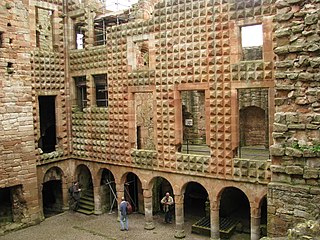
Francis Stewart, 5th Earl of Bothwell, was Commendator of Kelso Abbey and Coldingham Priory, a Privy Counsellor and Lord High Admiral of Scotland. He was a notorious conspirator who led several uprisings against his first cousin, King James VI, all of which ultimately failed, and he died in poverty in Italy after being banished from Scotland. Francis's maternal uncle, the 4th Earl of Bothwell, was the chief suspect in the murder of James VI's father, Lord Darnley.

John Stewart, Earl of Carrick, Lord Kinclaven was a Scottish nobleman, the third son of Robert, Earl of Orkney, a bastard son of King James V.
Jean Fleming, Countess of Cassilis (1553/4–1609) was a Scottish noblewoman and courtier at the court of James VI of Scotland, and a survivor of domestic violence.
Margaret Hartsyde or Hairtsyde was a Scottish servant, jewel thief, and landowner. A servant of the queen, Anne of Denmark, Hartsyde's duties included looking after the queen's jewels, dealing with the goldsmith George Heriot, and handling large sums of money.

Walraven III van Brederode (1547–1614) was a Dutch aristocrat and diplomat. He was a son of Reinoud IV van Brederode and Margaretha van Doerne, and became Lord Van Brederode on the death of his father in 1584. He married Gulielma van Haeften.

Henrietta Stewart (1573–1642) was a Scottish courtier. She was the influential favourite of the queen of Scotland, Anne of Denmark.
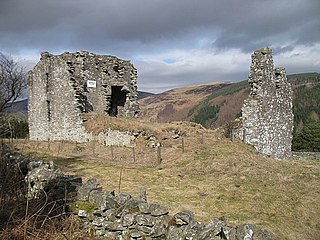
Sir Gideon Murray of Elibank, was a Scottish courtier and landowner.
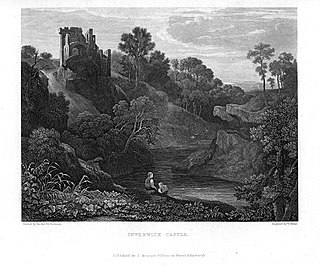
James Maxwell, 1st Earl of Dirletoun was a Scottish courtier and landowner, and Black Rod. He was involved in selling royal jewels.
William Murray of Tullibardine was a Scottish courtier and leader of the Clan Murray.
Robert Jameson was a Scottish shipowner from Ayr.
Henry Wardlaw of Pitreavie (1565–1637) was a Scottish courtier and administrator.
William Stewart of Caverston and Traquair, was a Scottish landowner and Captain of Dumbarton Castle.
John Cockburn of Ormiston was a Scottish lawyer and landowner.

Hilderston or Hilderstone in West Lothian, Scotland, was the site of the discovery of a vein of silver in 1606 and a mining operation that attracted international interest. King James used rumours of a silver bonanza to leverage a loan in the City of London. He took over the mine works, an act sometimes regarded as an example of nationalization. The enterprise may have inspired a satirical stage play. On 8 May 1608 work commenced under royal supervision. Miners from Cornwall and Germany were employed in the works.
References
- ↑ The Melros Papers, vol. 1 (Edinburgh, 1837), pp. 241.
- ↑ Register of the Privy Council of Scotland, vol. 11 (Edinburgh, 1894), p. 60.
- ↑ The Melros Papers, vol. 1 (Edinburgh, 1837), pp. 329-30.
- ↑ Register of the Privy Council of Scotland, vol. 11 (Edinburgh, 1894), pp. 593-4, 602-3.
- ↑ Register of the Privy Council of Scotland, vol. 12 (Edinburgh, 1895), p. 530, 606-7, 712-3.